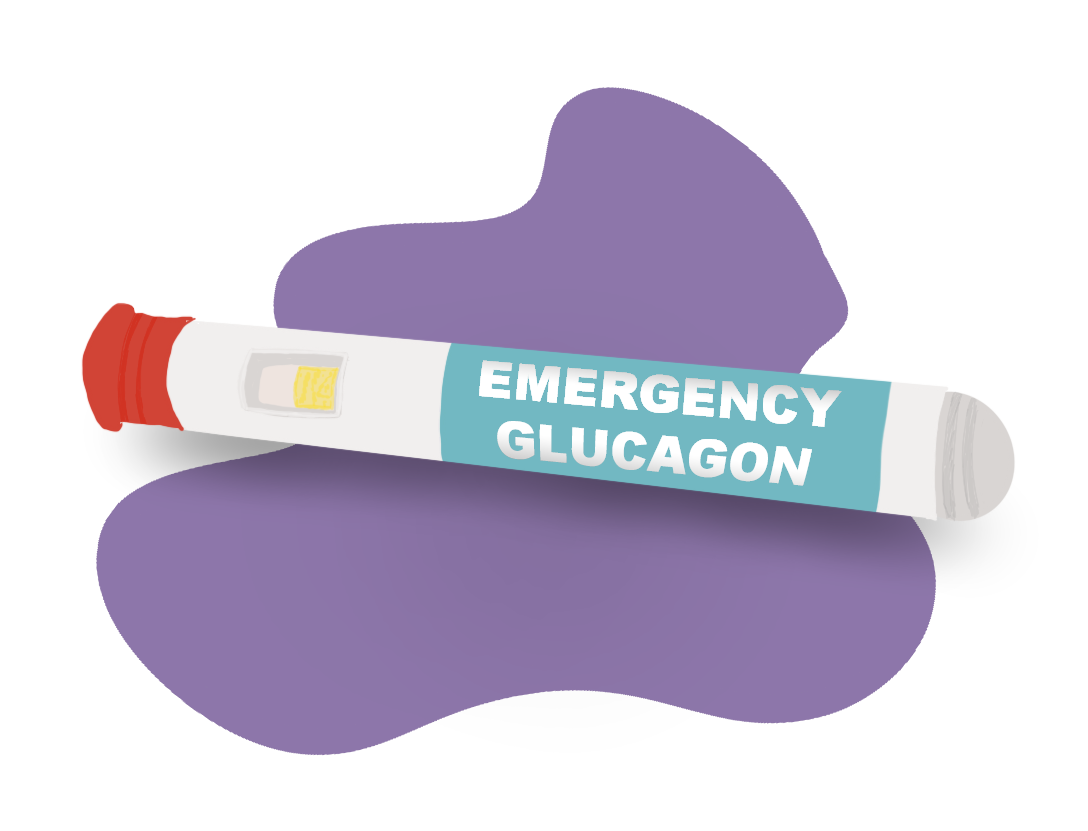Low Blood Sugar? Avoid the Emergency Room
 By Frida Velcani
By Frida Velcani
How to recognize and treat severe hypoglycemia quickly – with emergency glucagon – and avoid a trip to the hospital.
When you have diabetes, life can often feel like a juggling act to keep your glucose levels within your target range. Staying on top of your diabetes management is essential, but you may still face unpredictable and sudden swings in glucose levels due to medications, lifestyle (exercising), or illness. Hypoglycemia (low blood sugar) is when glucose values fall below 70 mg/dl as a result of too much insulin in the body for what your body needs at that time. When this occurs, your cells lack the glucose they need to produce energy.
There are three levels of hypoglycemia: level 1, glucose values fall below 70 mg/dL; level 2, glucose levels drop below 54 mg/dL; and level 3, referred to as severe hypoglycemia, which occurs when glucose levels are so low that you experience changes in thinking and reasoning and need support from others.
You should always treat lows right away, whether your blood sugar is below 70 mg/dL or trending toward that number. If your glucose levels drop below 54 mg/dl, you must act immediately to raise your blood sugar. If not treated quickly, severe hypoglycemia can occur and this can be very dangerous.
Glucagon can be used to quickly raise blood glucose levels in severe cases – when someone is vomiting, not able to swallow, or is unresponsive. Glucagon is a hormone (a natural chemical made by your body) that prompts the body to release stored sugar into your bloodstream. Glucagon is used to treat people with diabetes for severe hypoglycemia at home, and to avoid costly and frightening visits to the hospital. In the majority of cases, emergency glucagon is administered by someone else, so it is important that your care-partners, loved ones, friends, colleagues, and school staff know how and when to give you glucagon.
Part of being prepared for a low blood sugar emergency is knowing the signs as well as the treatment to return to stable glucose levels. You and your care-partners can learn about potential causes of low blood sugar here. In this article, we describe how to recognize severe hypoglycemia and the different glucagon rescue options available to people with diabetes in the event of an emergency.
What are the signs of dangerously low blood sugar?
Severe hypoglycemia is an extreme case of low blood sugar that occurs when a person’s body can’t supply the brain with glucose to properly function. During severe hypoglycemia, you may experience more serious symptoms than you normally feel when you have low blood sugar. Symptoms of hypoglycemia often follow a progression:
-
Shakes, sweatiness, and elevated heart rate
-
Hunger and weakness
-
Not enough sugar for the brain to fully function (called neuroglycopenia)
-
Confusion
-
Combativeness
-
Disorientation
-
Seizures
-
Loss of consciousness
-
It’s important to take these signs seriously when they occur. In many cases, the release of body hormones such as adrenaline will signal that your glucose levels are trending low – this is what causes initial symptoms. When the body doesn’t release these hormones or respond to the warning signals of hypoglycemia, this is referred to as hypoglycemia unawareness. If you have hypoglycemia unawareness you may not notice or experience the early symptoms of low blood sugar. People with diabetes who experience this condition are at increased risk of prolonged low glucose levels and should talk to their healthcare team about changes to their diabetes treatment plan and wearing a continuous glucose monitor (CGM), which can provide them with real-time glucose readings and set off an alarm when their glucose levels are too high or low.
For a list of common symptoms of low blood sugar, click here.
How to treat severe lows with emergency glucagon
Every emergency hypoglycemia kit should include glucose tablets or sugary snacks, glucagon, a glucose monitor (either a CGM or blood glucose meter), and emergency contact information. Emergency glucagon is available by prescription and can be injected or administered by nasal spray.
If you are a parent or caregiver for a child with diabetes, talk to their healthcare professional about the correct dose of emergency glucagon for children.
The recent development of ready-to-use and premixed glucagon has made it easier to administer rescue glucagon quickly and effectively in emergency situations. These next-generation glucagon options can save care-partners time, particularly if the person with severe hypoglycemia has lost consciousness.
-
Baqsimi is administered like a nasal spray and comes in a single-use dispenser that requires just three steps to use: (1) remove the device from tube; (2) insert tip of device into one nostril; (3) push plunger all the way down to administer dose. It does not require inhalation, meaning that it can be successfully administered by another person even if the receiver of the glucagon is unconscious. It is a needle-free glucagon option and works just as well as injectable glucagon.
-
Gvoke HypoPen is an emergency glucagon autoinjector with no visible needles. It requires two simple steps: (1) remove the cap; and (2) press the pen against the skin (the person’s arm, leg, or wherever is available). Upon contact with the skin, the automatic injector will deliver a rescue dose of glucagon and retract the needle. Gvoke also comes in a pre-filled syringe that is ready for manual injection as an alternative option to the HypoPen.
-
Zegalogue also comes in a pre-filled syringe or an auto-injector device. It has a similar effect to Baqsimi and Gvoke, resolving severe hypoglycemia much faster than traditional rescue glucagon. It is expected to be available in June.
To learn more about how to prepare for low blood sugar events, read “Hypoglycemia Preparedness: How to Know Before You Go Low." Read “Let’s Talk About the Lows” for tips for communicating with loved ones about low blood sugar emergencies.







